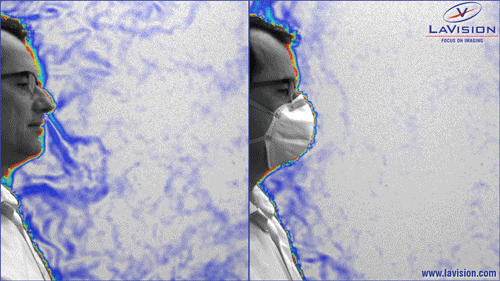New research at MIT using high-speed cameras has shown that aerosols from a sneeze could travel up to seven to eight metres.
The work could change the advice given by the World Health Organisation about whether more of us should be wearing masks during the coronavirus pandemic. As reported by the BBC, a panel of advisers to WHO will weigh up research on whether the virus can be projected further than previously thought through coughs and sneezes.
The work at MIT was carried out by Lydia Bourouiba. In the paper she said: 'Given the turbulent puff cloud dynamic model, recommendations for separations of 3 to 6 feet (1-2m) may underestimate the distance, timescale, and persistence over which the cloud and its pathogenic payload travel, thus generating an underappreciated potential exposure range for a healthcare worker.'
The study analysed video recorded at 2,000 frames per second. During a sneeze air and moisture droplets can be expelled at 10 to 30m/s.
As of 6 April, WHO recommends wearing a mask if the person is coughing or sneezing, and that masks are effective only when used in combination with frequent hand-cleaning with alcohol-based hand rub or soap and water.
On 3 April, the Centers for Disease Control and Prevention in the US issued new medical guidance advising Americans to wear non-surgical face masks to help slow the spread of the virus. Canada followed suit on 6 April.
Micro-droplets imaged by Toho University scientists
Researchers at Toho University in Japan have shown how micro-droplets released in conversation can drift through the air and potentially contribute to the spread of coronavirus.
The Japanese broadcaster NHK ran its own demonstration of the work; the translated TV segment can be viewed in the video below.
The team used laser beams and a high-sensitivity camera to visualise how micro-droplets as small as 0.1µm wide travelled between two people having a conversation. Although the droplets didn't spread as far through the air as through a sneeze, the tiny droplets could be seen floating in the air.
'Micro-droplets carry many viruses. We produce them when we talk loudly or breathe heavily. People around us inhale them, and that's how the virus spreads. We're beginning to see this risk now,' said Kazuhiro Tateda, president of the Japanese Association for Infectious Disease.
The risk of infection through micro-droplets becomes greater in a closed space with poor ventilation. In the same TV segment, a simulation - made by researchers at Kyoto Institute of Technology - was shown, which tracked the movement of micro-droplets in an airtight room.
Ten people were shown in a room about the size of a classroom. One person coughing sends around 10,000 droplets into the air - the larger droplets fall to the floor within one minute, whereas the micro-droplets continued to drift 20 minutes after the person had coughed.
'If the air isn't flowing, the micro-droplets won't move. And since they cannot move on their own, they stay in place for some time,' said Masashai Yamamkawa, associate professor.
The video showed how opening windows significantly helps lower the number of micro-droplets - especially if there are two areas of ventilation in different parts of the room.
Visualising airflow
Elsewhere, German laser imaging company Lavision has shown how exhaled air can be reduced using a face mask by visualising the air flow caused by a person breathing and coughing.

Credit: Lavision
The video was created using a Schlieren imaging technique, whereby a random dot pattern in the background of the flow is imaged with a high resolution camera before and during the test. By comparing the two pictures, the local displacement of the background pattern caused by the flow of gases can be seen.
A video from MIT from 2014.


